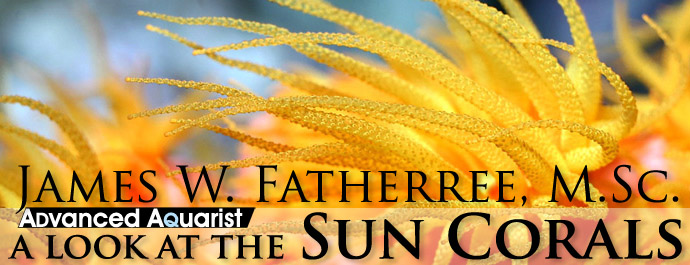
Almost all sorts of reef-building corals and most all of their reef-dwelling kin contain symbiotic zooxanthellae, and require bright light to live. Thus, these are called zooxanthellate corals, and they’re all restricted to life in relatively clear, shallow, warm, and well-lit waters. However, there are lots of other stony corals out there that don’t contain these algae and have no need for light. These are the non-symbiotic corals, which are properly called aposymbiotic or azooxanthellate species.
These unique corals still build a calcium carbonate skeleton, just like zooxanthellate stony corals, and they have feeding tentacles, too. In fact, they have relatively large tentacles, as they rely strictly on capturing plankton and particulate matter to stay alive. Some live as solitary individuals, but many others form small colonies, and a few can even form structures over a meter across, as well. A few are completely clear or white in color, which is unique to azooxanthellate species, but most all of them come in various colors. So, if you didn’t know exactly what you were looking at, you’d never know that the vast majority of these corals were any different from their light-loving cousins.
There are a few that live amongst their zooxanthellate relatives, finding their own place in tropical reef environments, but most of these azooxanthellate corals live in other sorts of habitats. They don’t need light, so they can live in caves and such, but they can also live at any depth. Zooxanthellate corals are restricted to shallow waters where they get plenty of sunlight, but azooxanthellate corals have no such restrictions and have been found at depths of thousands of meters. They can also live in much colder waters, and often do.
In fact, scientists are also finding out more and more about the widespread presence of entire reef systems that are formed by azooxanthellate corals in deep/cold waters. These are entirely different ecosystems of course, but they are most certainly reefs. If you’re interested, check out Cold-water Coral Reefs: Out of Sight – No Longer Out of Mind, published by the United Nations Environmental Programme-World Conservation Monitoring Centre, which is available online1. Very interesting, indeed.
Anyway, getting to the specific topic… There are numerous species of azooxanthellate stony corals out there, but more than likely the only ones you’ll ever come across in the hobby are known as the sun corals, some of which are called orange cup corals. This umbrella of a common name is used for several species of the genera Tubstraea and Dendrophyllia, and these are the subject from here on out.
Identification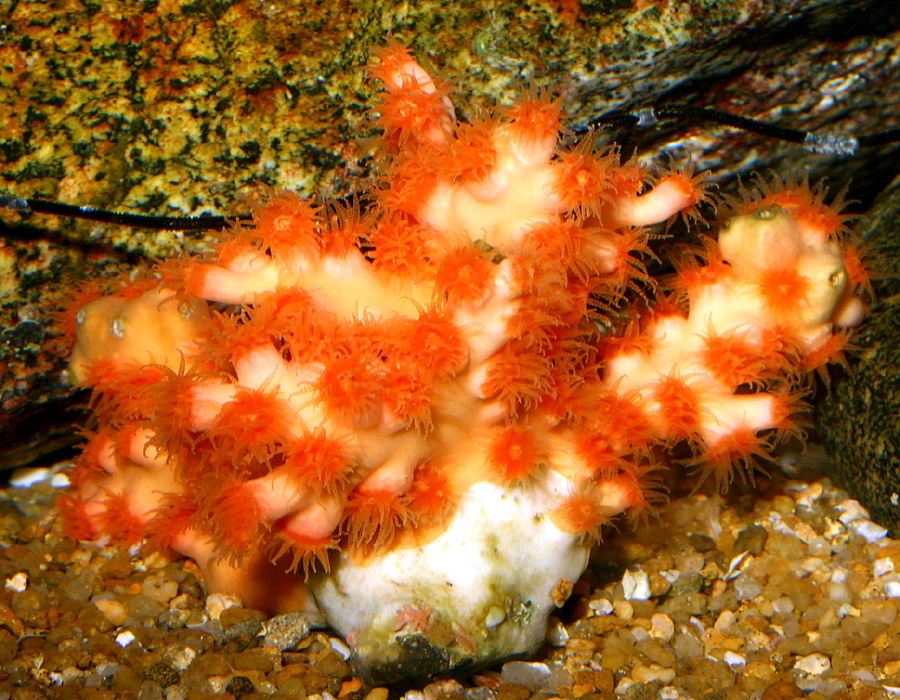
The sun corals we see in the hobby start out as single polyps, but they typically develop into fist-sized colonies that are colored in red to orange to yellow, or uncommonly pink. The tentacles may be the same color as the thin tissue that covers the rest of a colony, and are rather translucent, but sometimes they’re lighter in color or even white. The tentacles are also dotted with numerous visible batteries of nematocysts used to capture food items.
While some species have polyps that are independent of each other, the polyps of most sun corals form relatively tall cylinders that rise from a typically ball-like base. Regardless of growth form, the polyps can also completely retract their tentacles when not feeding. In fact, the tentacles often spend several hours at a time closed down, primarily during the day, with a thin sheath of tissue closed over the top of the polyp in a draw-string fashion that keeps them out of sight. This is normal behavior, but do keep in mind that they shouldn’t stay closed all of the time. After acclimation to an aquarium, which may take several days, the polyps should open up and take food when it is offered. More on that in a minute, though.
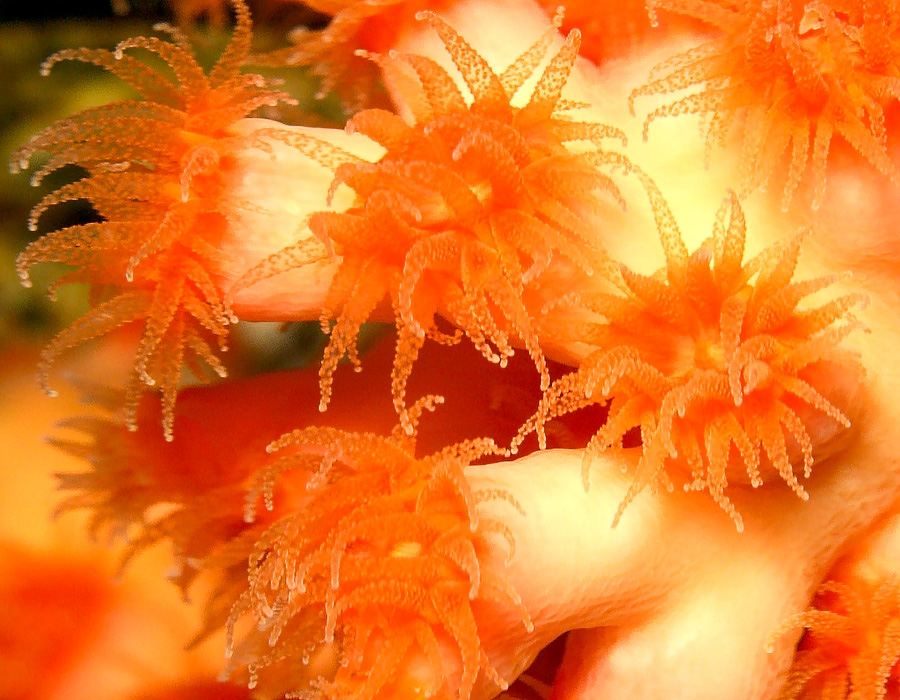
If I had to guess, I’d say this is Tubastraea coccinea, since I found one source that says it is branching species. However, that’s only a guess.
All in all, there are 7 species of sun corals in the genus Tubastraea2, and another 23 species in the genus Dendrophyllia3. However, according to Borneman4, any specimens of sun coral seen for sale are most likely Tubastraea faulkneri or T. coccinea, as these are the two most commonly imported species. However, many species of Tubastraea and Dendrophyllia are so similar in appearance that they cannot be identified at the species or even generic level without a close examination of some features that can only be examined when a specimen is dead.
To show how futile it can be trying to pin a specific name on some sun coral specimens, here’s what I found when I thumbed though a few of the books on my shelf: Fossa and Nilsen5 state “…it is very difficult to distinguish the Dendrophyllia and Tubastraea species from one another. A determination is only possible based on the form and position of the mesenterial filaments, characteristics which are impossible to recognize in living animals.” Next to a photograph in Delbeek and Sprung6 the authors state “These look like Dendrophyllia, but cannot be distinguished from Tubastraea without examining the skeletal structure of the corallites.” And, Veron7 states “Tubastraea and Dendrophyllia are not distinguishable without examination of the pattern of septal fusion.”
So, despite the fact that Tubastraea faulkneri or T. coccinea are supposedly the most common species available, with one distinct exception that I’ll get to later and one identified under its photo below, I’m not sure that importers or hobbyists really have any idea what species any given sun coral specimen is, or even what genus it’s in for that matter. While Fossa and Nilsen3 note that T. coccinea has a branching skeleton and T. faulkneri does not, after spending a considerable amount of time online I have been unable to find any sort of an identification key that points out any differences between these two species, much less any of the other similar species. Thus, for the most part, I’m not even going to try to identify any of these.
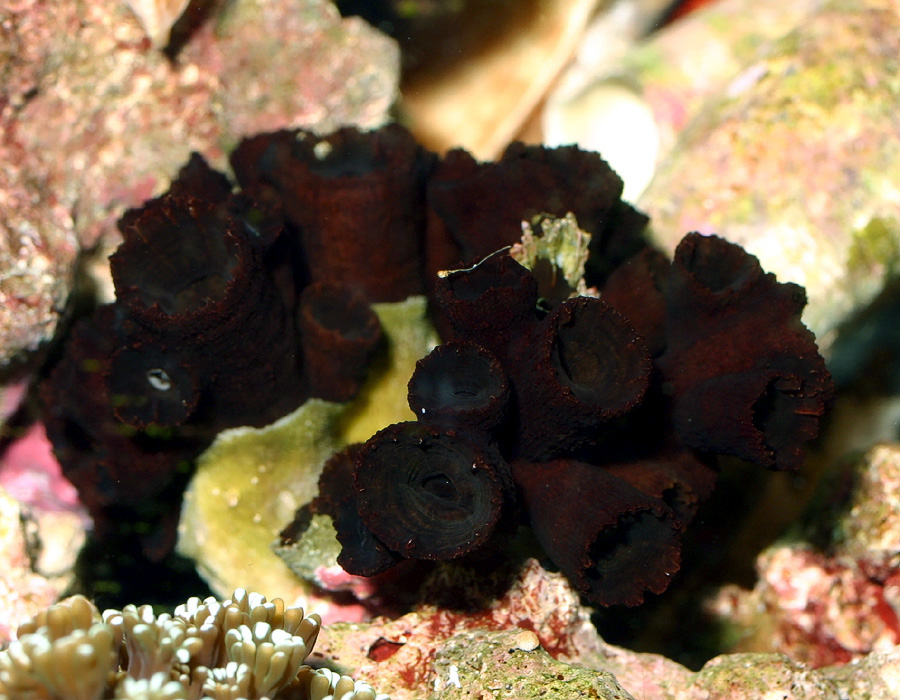
Here’s one of the sun corals that can easily be identified at the species level. It’s Tubastraea diaphana, which is dark-colored but does not form a branching skeleton like T. micrantha (covered below).
Regardless, as best as I can tell, all of these look-alikes have the same care requirements, and not knowing exactly what is what is unlikely to have any effect on your chances of success or failure with them. So, let’s get on with the aquarium husbandry of sun corals, starting with water quality requirements.
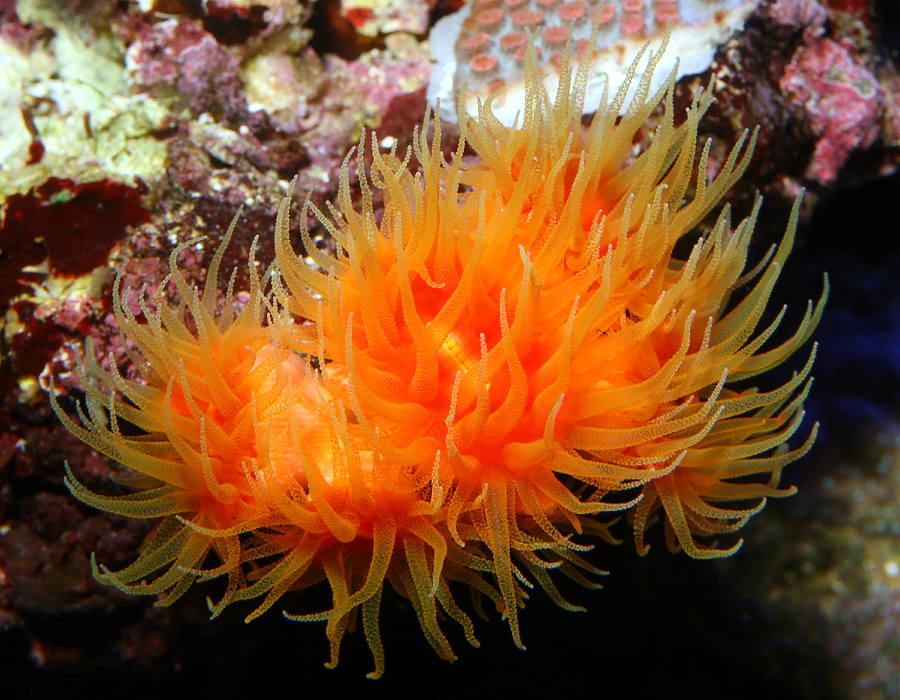
While identification is difficult, I did find that the polyps of Dendrophyllia are often oval and larger in diameter than those of Tubastraea. So, I’m thinking this might be a dendrophyllid.
Water Quality
As mentioned above, despite being azooxanthellate, sun corals still build a calcium carbonate skeleton just as other stony corals do. And, they’re adapted to life in reef waters, so water quality should be the same as it would be for any other stony corals.
The salinity should be in the range of 1.023 to 1.027 as measured using its specific gravity. The temperature should stay in the range of about 72° to 84°F. However, somewhere around 75° to 81°F is really the optimal range you should try for, as this is perfectly suitable for corals and gives some room up and down if your heater/air conditioner should ever fail. The concentration of calcium, the pH, and the alkalinity of the aquarium’s water are particularly important for all stony corals too, so all three of these must be maintained at acceptable levels, as well. Keeping calcium concentrations in the range of 400 to 450ppm is optimal, but they can be a bit lower or higher. The pH should optimally be kept around 8.2 to 8.4, and alkalinity should be kept in the range of 7 to 12dKH, although these often go a little higher or lower, as well.
Lastly, you’ll also need to keep waterborne nutrients at minimal levels, particularly phosphorus in the form of phosphates. The presence of phosphates can affect the production of calcium carbonate skeletal material by stony corals, and elevated phosphate levels can shut down its production completely. In addition, phosphates also act a great fertilizers, but for all the wrong stuff. Elevated phosphate concentrations can quickly lead to the rapid growth unwanted algae, which can really muck up an aquarium and can even overgrow and kill many corals.
It is particularly important to think about this with respect to sun corals, as they lack zooxanthellae and will require significant amounts of food on a regular basis (covered below). Adding enough food to keep sun corals healthy can easily lead to unsuitable nutrient levels in a closed aquarium system, and that’s really the single biggest issue with respect to caring for these corals. It can be difficult enough to keep nutrient levels low in a “regular” reef aquarium, but the constant addition of extra foods can make it even harder. Thus, you’ll very likely need to use a good skimmer and perform more frequent and/or larger water changes than normal in order to keep things in check.
For example, you can find two articles online8/9 covering the aquariums of Mike Cao, which are stocked with a variety of azooxanthellate corals. He started with a 20 gallon aquarium, and was doing two 25% water changes a week (yes, that’s 200% per month), using activated carbon, running an oversized skimmer, and using ozone in order to keep nutrient levels in check. Then he created a multiple tank system with a total volume of 155 gallons. Now he’s doing 22.5% water changes weekly (90% per month), and is still using carbon, a large skimmer, and ozone. That obviously quite demanding. Of course, you may get by just fine doing something much closer to “regular” maintenance if you only have one or a few sun coral specimens in a relatively large aquarium. Regardless, the bottom line is that it’s important to remember that the more food that goes in, the more time, effort, and money it’s going to take to keep nutrients levels low.
Feeding
Again, sun corals have no zooxanthellae, so they’ll obviously rely on capturing food particles to stay alive. Fortunately, they can feed on relatively large bits of food and can be kept healthy using a variety of things, which can be target fed directly to polyps using a turkey baster or large needleless syringe, or by adding other sorts of foods to the whole tank. Brine shrimp, mysis shrimp, rotifers, copepods, etc. and even bits of chopped fish, clam, or other marine meats can be used. Soaking bits of such foods in a vitamin supplement is often suggested, as well.
While many hobbyists have been successful feeding sun corals every two or three days, some suggest that doing so daily is best. Some hobbyists even use a drip/dosing system to constantly add zooplankton products, oyster eggs, etc. However, I’ve found that using a turkey baster every other day will get the job done just fine, and numerous other hobbyists have been successful doing the same.
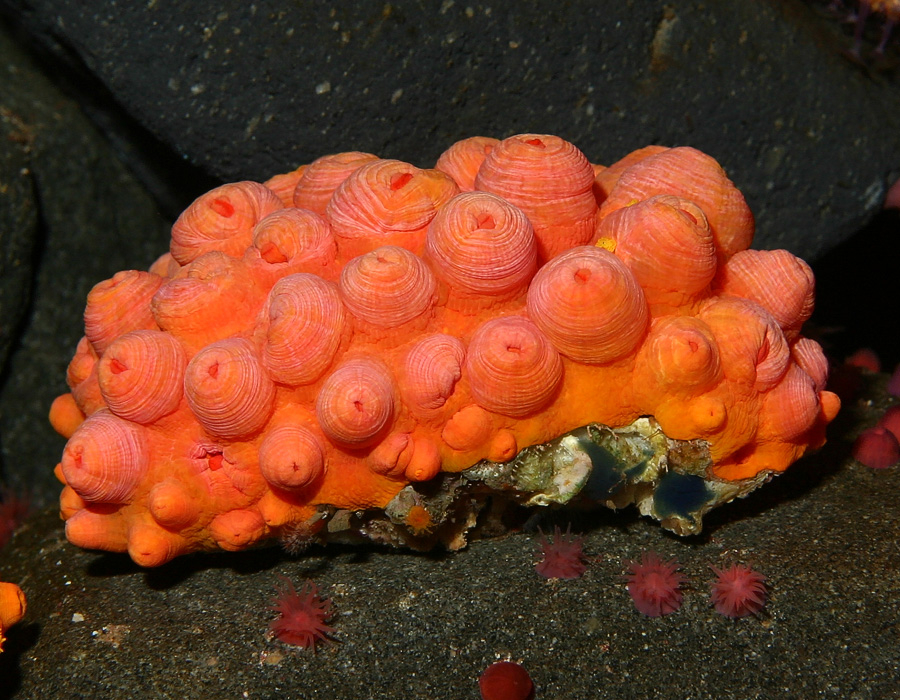
Sun corals typically extend their tentacles when feeding, but may spend most of the time with them retracted.
Regardless of the timing, a good way to do the job if a specimen’s tentacles aren’t extended when you’re ready to feed is to put whatever food you’re using into a shot glass along with some water from the tank. Swirl the food around a bit (and let it thaw if it’s frozen), and suck up a little bit of the water with a baster/syringe, then squirt a little of the water over a specimen. This will typically elicit a feeding response, and the tentacles should emerge within a few minutes. At that point you can go ahead and suck up some of the food and begin squirting it into the waiting tentacles.
With that said, it’s also interesting (and convenient) that with some diligence it’s typically possible to train a specimen to eat at a particular time. While many new specimens seem reluctant to extend their tentacles, if you make attempts to feed a specimen at the same time every day for anywhere from a couple of weeks to a couple of months, it’ll catch on. Once a specimen begins to consistently open up and feed at that time, it’s common to see them opening up in anticipation of food before any is even added. Once that happens, you can obviously skip the teasing step of feeding it and skip straight to adding the food.
Also, when feeding you’ll need to see that each polyp receives its own meal. This is especially important for species that have polyps that are not connected together by soft tissue, and for normally connected species that are suffering from any tissue loss between the polyps. Once a polyp has some food it will ingest it and momentarily retract its tentacles. So, it should be easy enough to see if they’ve all gotten something to eat.
If you aren’t giving them enough of what they need, the first clear sign of trouble is often a lack of polyp expansion, which is followed by a deterioration of the thin sheet of tissue that covers the skeletal area between the polyps. Once it starts to go, the rest will soon follow if things aren’t changed quickly. To make matters worse, algae will oftentimes show up on any exposed area where the tissue has died, which can lead to further tissue loss and can also make it more difficult for a specimen to recover if feeding is increased. So, it is imperative that you take action if you see any such signs of ill-health.
Oh, and I almost forgot. If you use any sort of food that is big enough to attract the attention of your fishes, be sure to feed them first and feed them well. If you don’t they’ll oftentimes gobble up anything you try to give to a sun coral.
Current
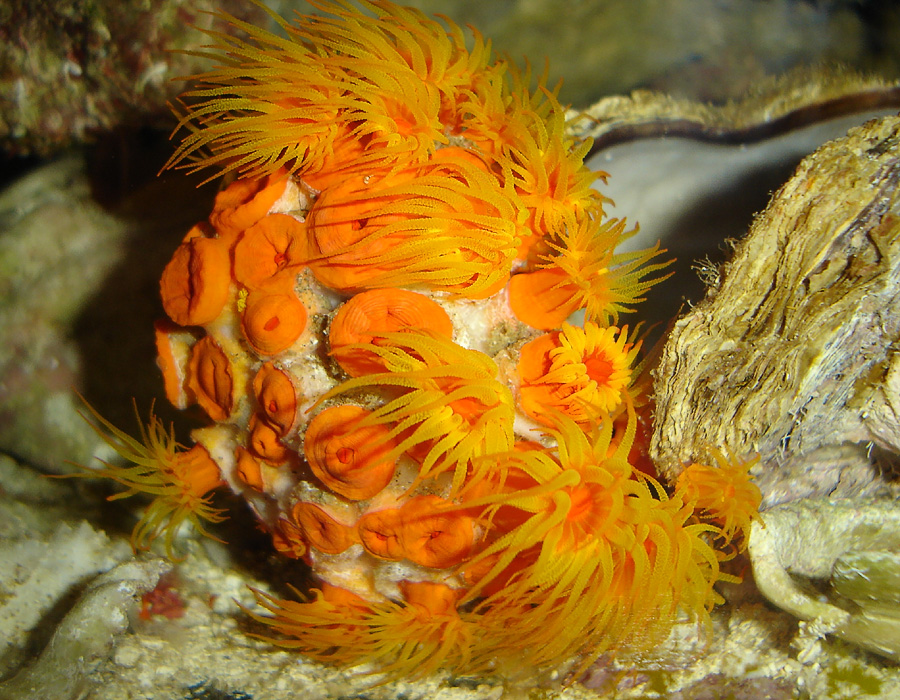 Sun corals are found in areas where there is sufficient water motion to bring them food, and to keep them clean and free of sediment, too. So, all of them will do best where water flow is moderate to strong. For species that have a layer of tissue connecting the polyps at their base, keep in mind that if the flow is too low sediment can easily settle onto this tissue and collect over time, especially if they’re not placed in a vertical or upside position. Thus, you’ll need to keep a close watch on any such specimen and make sure that it is getting a strong enough current to prevent this from happening. If sediment does accumulate on a specimen it will typically lead to tissue loss in the covered area.
Sun corals are found in areas where there is sufficient water motion to bring them food, and to keep them clean and free of sediment, too. So, all of them will do best where water flow is moderate to strong. For species that have a layer of tissue connecting the polyps at their base, keep in mind that if the flow is too low sediment can easily settle onto this tissue and collect over time, especially if they’re not placed in a vertical or upside position. Thus, you’ll need to keep a close watch on any such specimen and make sure that it is getting a strong enough current to prevent this from happening. If sediment does accumulate on a specimen it will typically lead to tissue loss in the covered area.
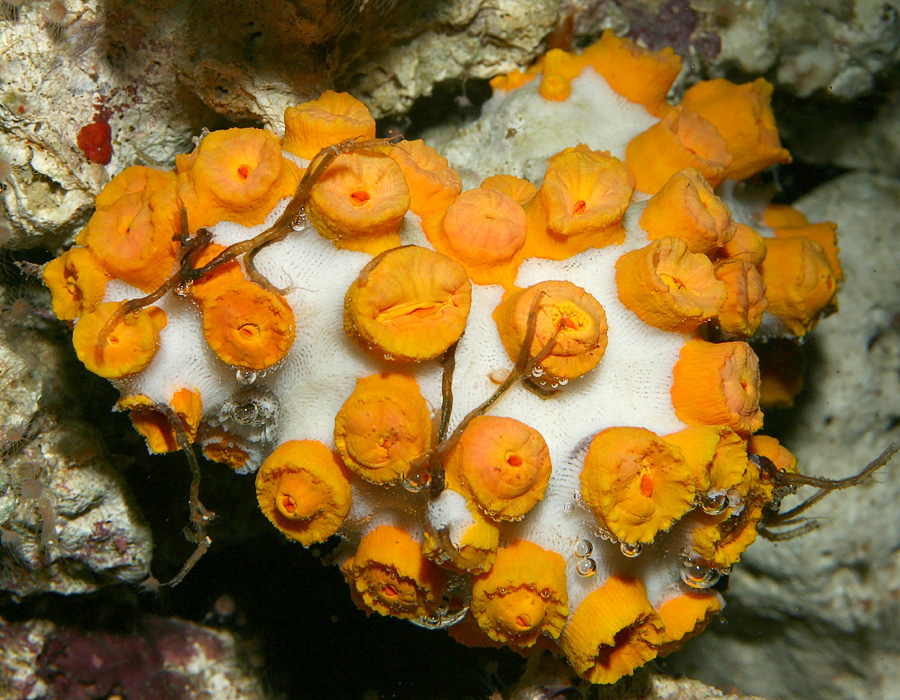
This is what a sun corals typically look like when unhealthy. The tissue that covers the colonies’ bases has disappeared, which often leads to further problems and death if water quality and flow is not improved and/or feeding is not increased.
Aggression
Despite having relatively large batteries of nematocysts lining their tentacles, sun corals are not aggressive and should not cause troubles for other corals in an aquarium. To the contrary, they’re more likely to be the victim of a more aggressive species, so pay attention to how close they may be placed to such neighbors.
Placement
Sun corals are typically found in shaded and dark areas, such as the undersides of overhangs and in open caves. However, if space is available, they can also be seen in many other areas, too. I’ve seen them cover entire walls at times, where there was little or no competition from other types of corals. Regardless of location, they’re always firmly attached to the substrate, and most are found in a vertical orientation or upside down. This likely helps to keep sediment from settling and collecting on the tissue covering the areas of a colony down between the polyps. Due to their lack of zooxanthellae, they can also live much deeper than most corals, being found as deep as about 360 feet2.
The absence of light obviously doesn’t hurt these corals. So, a specimen can be placed anywhere that there’s a sufficient current to keep it clean and where it won’t be potentially harmed by other corals. It’s okay to place a specimen on the bottom, but it’s far better to place it in a vertical or even upside down orientation and attach it to the rockwork using glue or epoxy. Drilling a hole in a colony and attaching it to some live rock with plastic screws is another option that works well when done properly. You do need to keep in mind that no matter where you place a specimen, you’ll need to be able to get at it at feeding time without too much trouble, though.
Also note that light certainly won’t harm a sun coral as long as it is slowly acclimated. Any specimen should initially be placed where it doesn’t get much light at all, then it can slowly be moved out/up into a more brightly lit area over a period of several days to a couple of weeks depending on the intensity of your lighting.
Reproduction
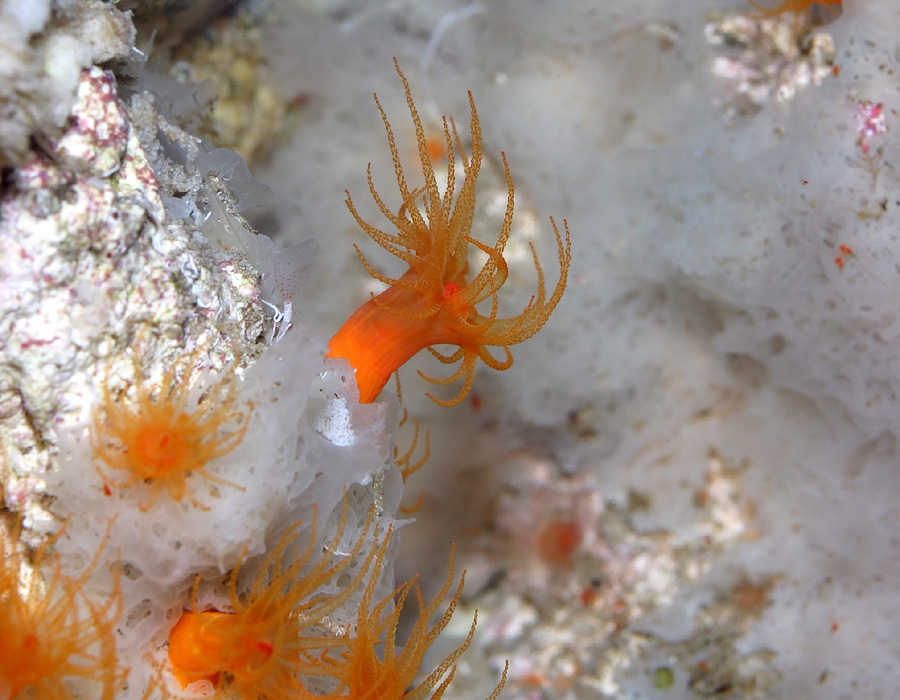
Under optimal conditions, sun corals may reproduce rapidly. These new polyps seem to arise from nowhere where parent colonies produce offspring in aquariums.
Under optimal conditions, sun corals can reproduce quite rapidly in a number of different ways. First, they can produce small versions of themselves, called polyp buds or balls, which grow from a parent polyp until they are large enough/heavy enough to break away. Then they settle somewhere else and begin the formation of a new colony10.
Second, sun corals are hermaphroditic and can also reproduce sexually and/or asexually by producing planulae larvae11/12, which they will also do in aquariums at times. These can drift around an aquarium until they eventually settle and develop into a new colony. So, don’t be surprised if new colonies seem to spring up from nowhere in an aquarium containing a well cared for specimen.
And there’s more… While I haven’t heard of anything like this occurring in an aquarium, some sun corals can produce “runners” that can extend several inches per year from a parent colony. Then, new polyps can develop at the ends of the runners, leading to the formation of a new colony13. Sounds a lot like the stolons that daisy polyps and such form.
Lastly, if you’re interested in manual propagation, it can be done. Healthy colonies can be cut into fragments using a small saw or power tool. But, that’s another topic.
Lastly, a warning
Before stopping there’s one species, Tubastraea micrantha, commonly called the black sun coral, that I have to warn you about. It isn’t offered very often, but that’s a good thing, as its survival record in aquariums is dismal to say the least.
It looks quite different, forming a branching skeleton covered with fluorescent dark olive green to brownish black tissue and tentacles. Ittypically grows in a rather two-dimensional branching form, as well. It can also get rather large, as individual specimens can grow into fan-shaped colonies that may be up to a few feet across at times, with the branches being thicker than a big finger.
For reasons unknown, the black sun coral apparently requires especially high current, and while I’ve never tried to keep this species in an aquarium myself, from what others have said it seems that it needs considerably more food input than the other sun corals. While it isn’t clear if it’s the quantity, quality, or delivery of food in aquariums that’s the problem (or all of the above), this species apparently has almost no chance of surviving long-term in captive systems no matter what or how you try to feed. It has been unanimously black-listed by those in the know, and Fossa and Nilsen5 state quite plainly, “We are of the opinion that it is not possible to maintain this species successfully in reef aquaria.” I think that should get the point across.
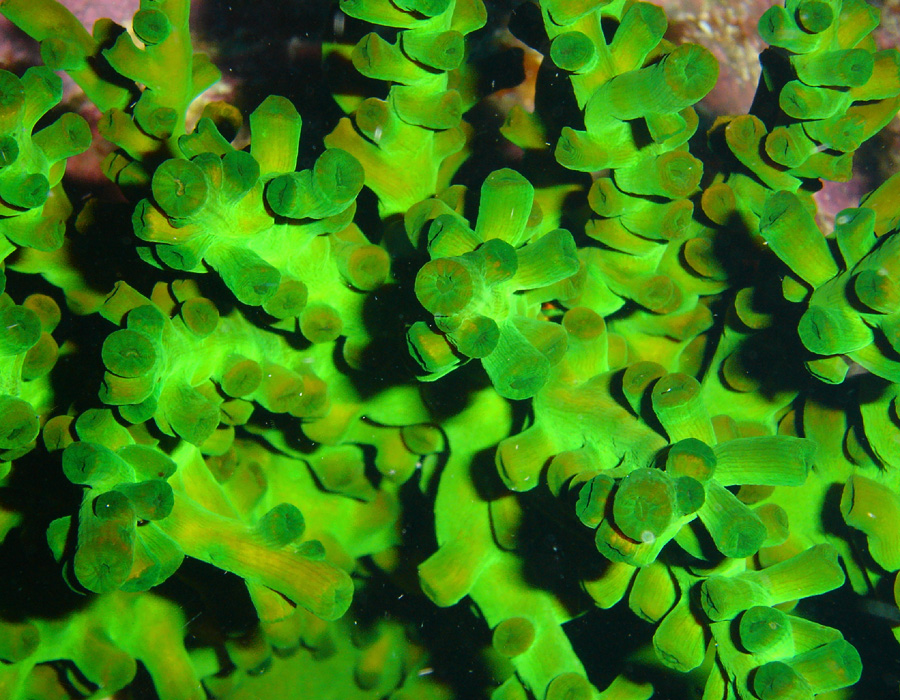
This is Tubastraea micrantha, the black sun coral, which is apparently exceptionally difficult to keep long-term in aquaria. I found this beautiful specimen off the coast of Sulawesi, Indonesia.
And with that said, it should be clear at this point that, despite their appearances in stores, none of these corals are as easy to care for as the zooxanthellate corals we keep in our aquariums. So avoid the black sun coral completely, and be ready to do what it takes and put forth the extra effort if you think you want to try a sun coral in your tank. If you’ll provide them with ample food supplies and good conditions, they can certainly thrive in aquaria and even reproduce, thus there’s no need to shy away from the other species of sun coral if you’re up to the task.
References
- Freiwald, A. et al. 2004. Cold-water Coral Reefs: Out of Sight – No Longer Out of Mind. UNEP-WCMC, Cambridge, UK. URL: http://www.unep-wcmc.org/medialibrary/2010/09/10/29fefd54/CWC.pdf
- World Register of Marine Species. URL: http://www.marinespecies.org/aphia.php?p=taxdetails&id=267930
- Marine Species Identification Portal. URL: http://species-identification.org/species.php?species_group=corals&id=38&menuentry=groepen
- Borneman, E. 1997. Tubastraea The Striking Sunflower Coral. URL:
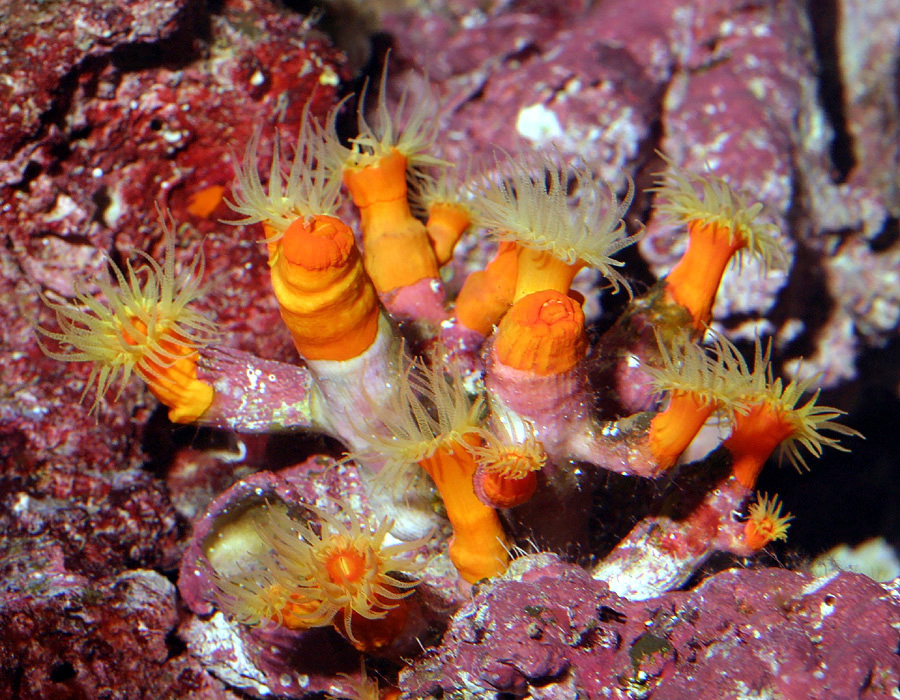 http://www.reefs.org/library/aquarium_net/0797/0797_3.html
http://www.reefs.org/library/aquarium_net/0797/0797_3.html - Fossa, S. and A. Nilsen. 1998. The Modern Coral Reef Aquarium, Volume 2. Birgit Schmettkamp Velag, Bornheim, Germany. 479pp.
- Delbeek, J.C. and J. Sprung. 1994. The Reef Aquarium: Volume One. Ricordea Publishing, Coconut Grove, FL. 544pp.
- Veron, J.E.N. 2000. Corals of the World, Vol. 2. Australian Institute of Marine Science, Townsville, Australia. 429pp.
- Blank, B. 2011. Uhuru’s Stellar Azoox Nano Reef. URL: http://reefbuilders.com/2011/04/25/uhurus-azoox-nano-reef/
- Cao, M. 2011. Feature Aquarium: Mike Cao’s Non-Photosynthetic Reef. URL: http://www.advancedaquarist.com/2011/1/aquarium
- Borneman, E. 2001. Aquarium Corals – Selection, Husbandry, and Natural History. T.F.H. Publications, neptune City, NJ. 464pp.
- Glynn, P.W., et al. 2008. Reproductive ecology of the azooxanthellate coral Tubastraea coccinea in the equatorial eastern Pacific: Part V. Dendrophylliidae. Marine Biology 153: 529-544.
- Ayre, D.J. and J.M. Resing. 1986. Sexual and asexual production of planulae in reef corals. Marine Biology 90:187-190.
- Vermeij, M.J.A. 2005. A novel growth strategy allows Tubastrea coccinea to escape small-scale adverse conditions and start over again. Coral Reefs 24:442.
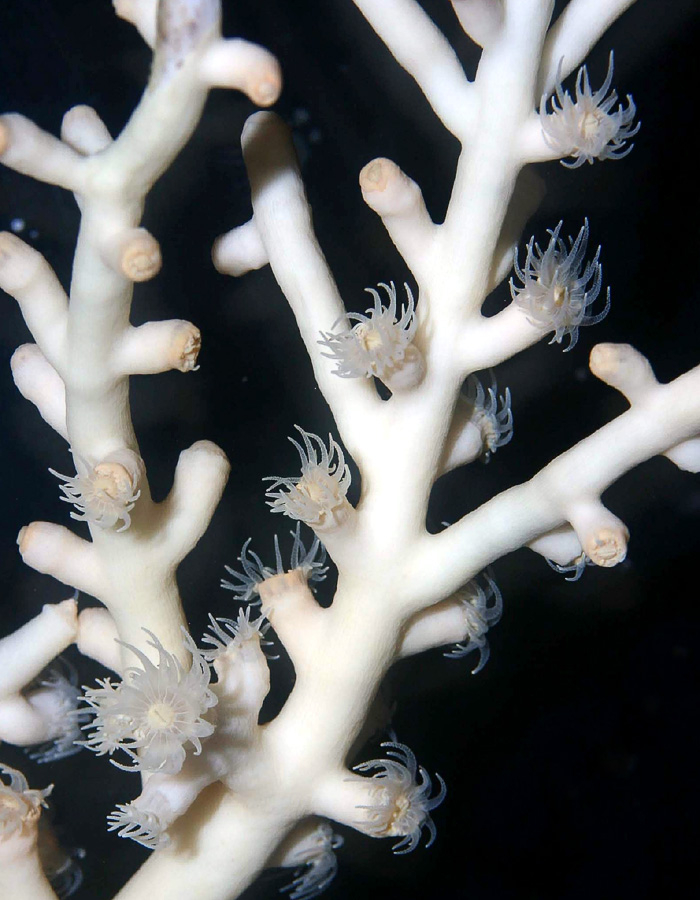
This is quite unusual too, as it’s a branching, white azooxanthellate stony coral that I also saw at an aquarium in Japan.


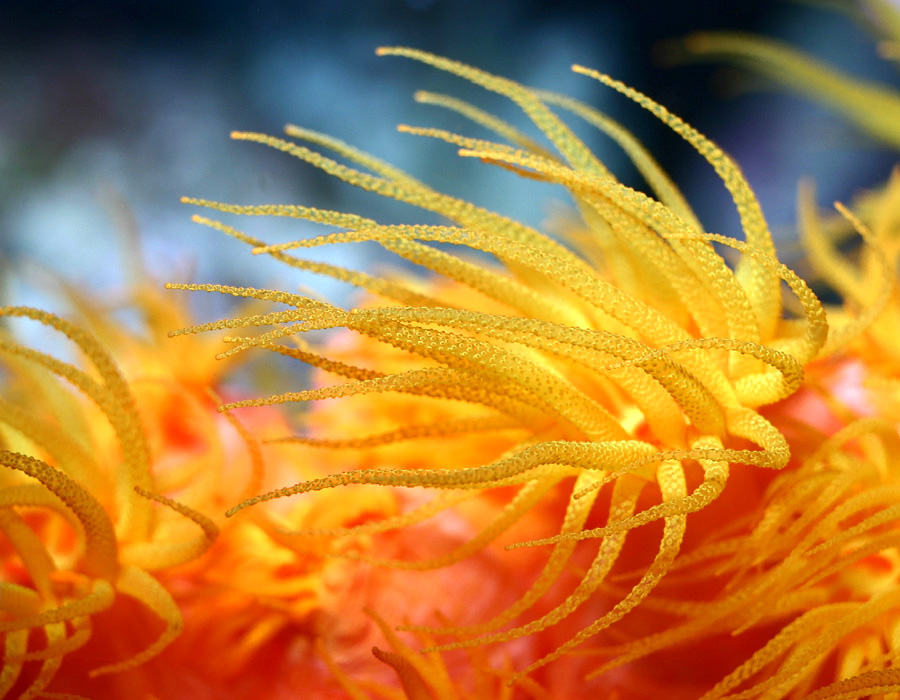
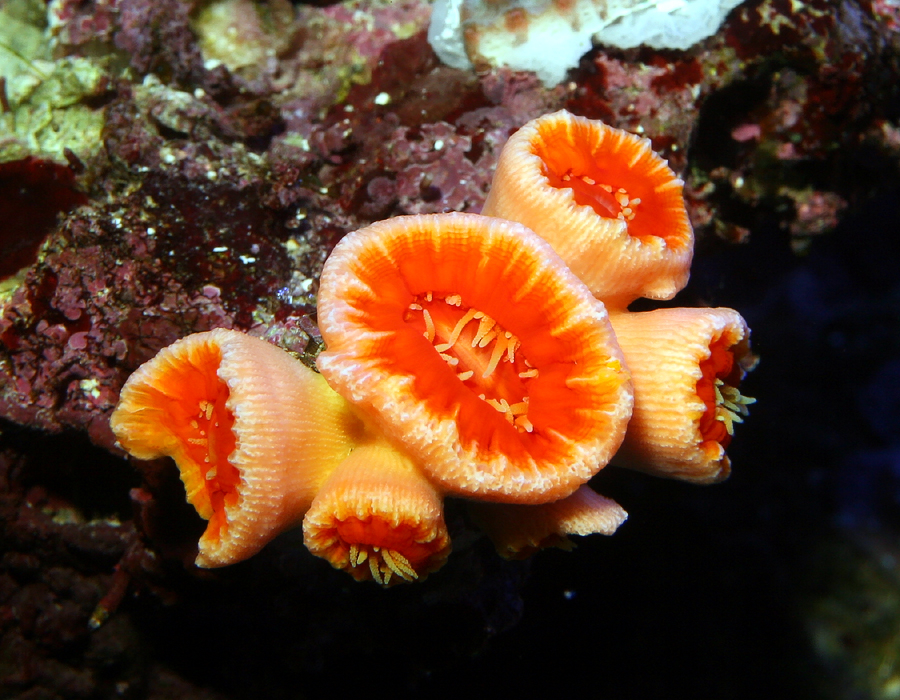
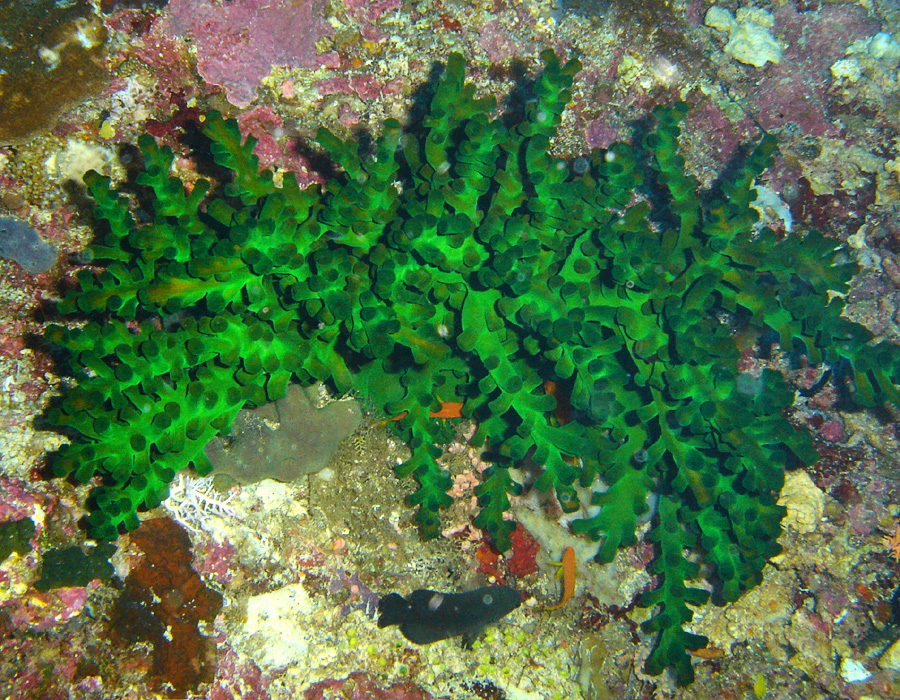
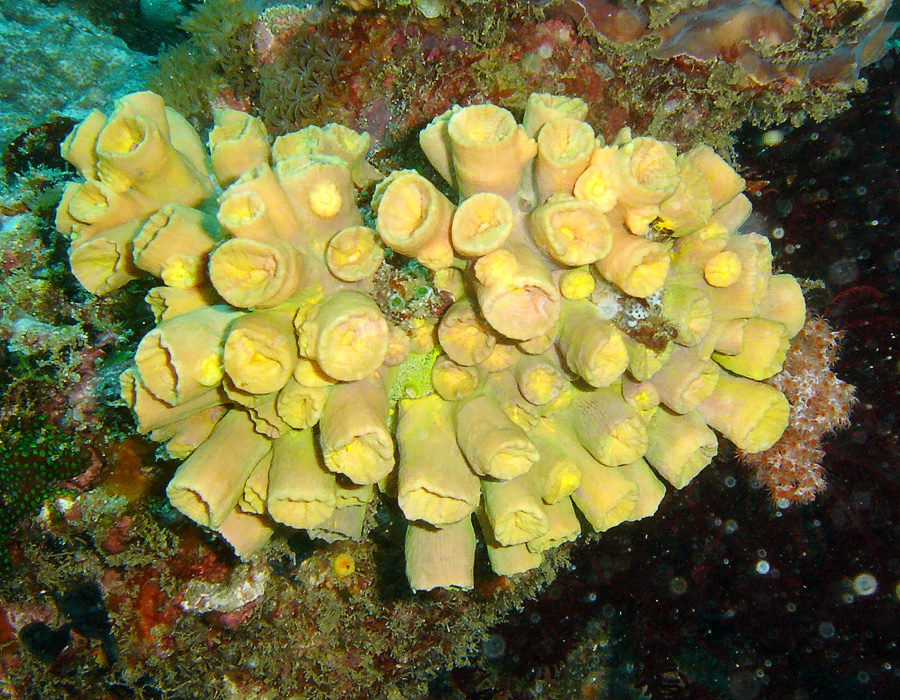
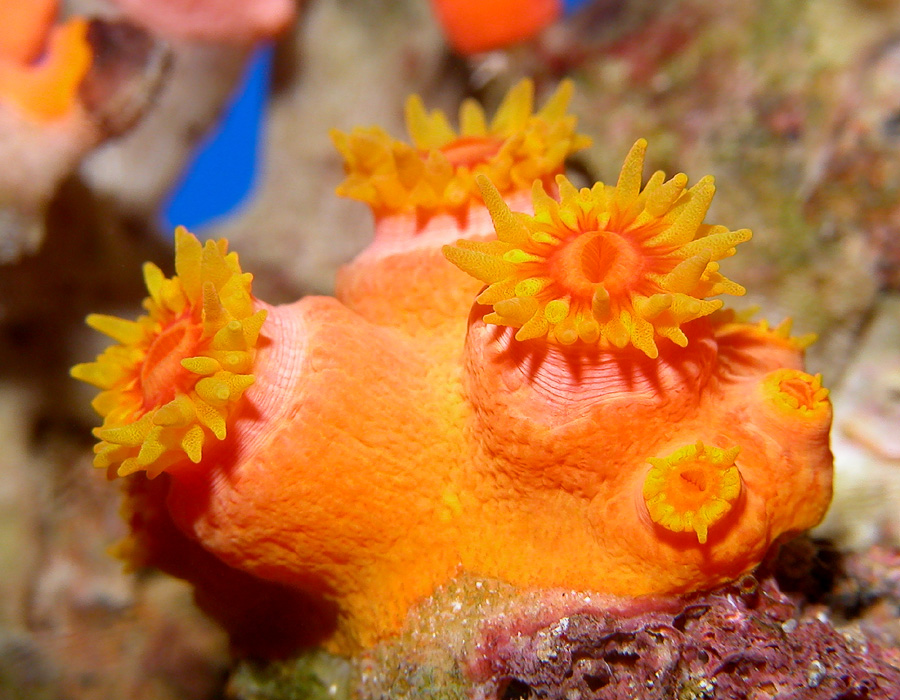
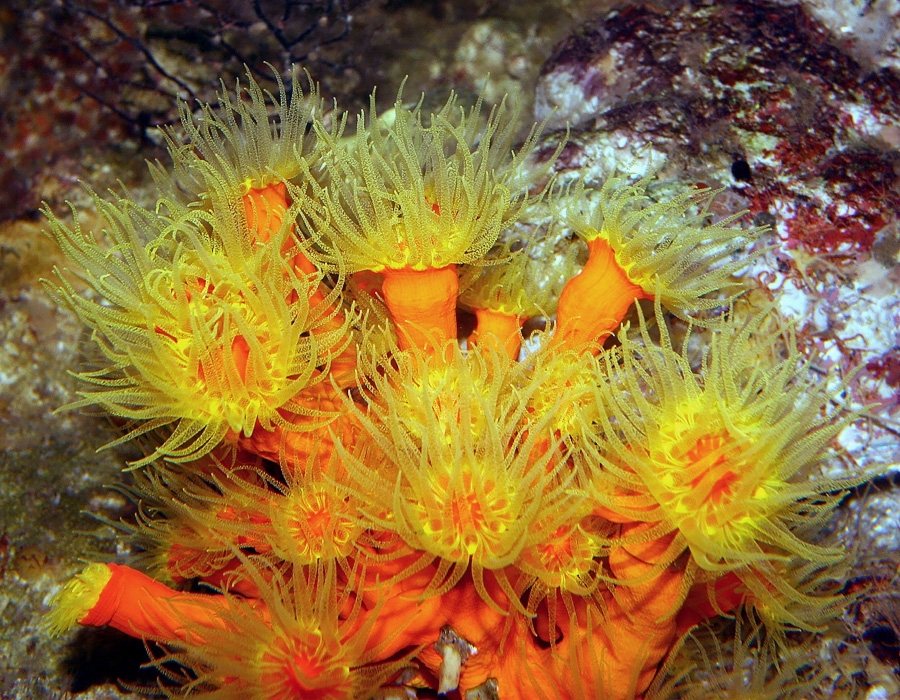

0 Comments